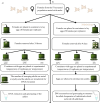6Pgdh polymorphism in wild bulb mite populations: prevalence, environmental correlates and life history trade-offs
- PMID: 38597987
- PMCID: PMC11182828
- DOI: 10.1007/s10493-024-00909-4
6Pgdh polymorphism in wild bulb mite populations: prevalence, environmental correlates and life history trade-offs
Abstract
Genetic polymorphism in key metabolic genes plays a pivotal role in shaping phenotypes and adapting to varying environments. Polymorphism in the metabolic gene 6-phosphogluconate dehydrogenase (6Pgdh) in bulb mites, Rhizoglyphus robini is characterized by two alleles, S and F, that differ by a single amino acid substitution and correlate with male reproductive fitness. The S-bearing males demonstrate a reproductive advantage. Although the S allele rapidly fixes in laboratory settings, the persistence of polymorphic populations in the wild is noteworthy. This study examines the prevalence and stability of 6Pgdh polymorphism in natural populations across Poland, investigating potential environmental influences and seasonal variations. We found widespread 6Pgdh polymorphism in natural populations, with allele frequencies varying across locations and sampling dates but without clear geographical or seasonal clines. This widespread polymorphism and spatio-temporal variability may be attributed to population demography and gene flow between local populations. We found some correlation between soil properties, particularly cation content (Na, K, Ca, and Mg) and 6Pgdh allele frequencies, showcasing the connection between mite physiology and soil characteristics and highlighting the presence of environment-dependent balancing selection. We conducted experimental fitness assays to determine whether the allele providing the advantage in male-male competition has antagonistic effects on life-history traits and if these effects are temperature-dependent. We found that temperature does not differentially influence development time or juvenile survival in different 6Pgdh genotypes. This study reveals the relationship between genetic variation, environmental factors, and reproductive fitness in natural bulb mite populations, shedding light on the dynamic mechanisms governing 6Pgdh polymorphism.
Keywords: Rhizoglyphus robini; 6-Phosphogluconate dehydrogenase; Balancing selection; Genetic polymorphism; Genotype–environment interaction for fitness; Metabolic gene.
© 2024. The Author(s).
Conflict of interest statement
The authors have no financial or non-financial interests to disclose.
Figures





Similar articles
-
Sexual and ecological selection on a sexual conflict gene.J Evol Biol. 2020 Oct;33(10):1433-1439. doi: 10.1111/jeb.13680. Epub 2020 Jul 31. J Evol Biol. 2020. PMID: 32654292
-
Proximate mechanisms of the differences in reproductive success of males bearing different alleles of Pgdh - a gene involved in a sexual conflict in bulb mite.J Evol Biol. 2018 May;31(5):657-664. doi: 10.1111/jeb.13250. Epub 2018 Mar 23. J Evol Biol. 2018. PMID: 29469939
-
Enzyme polymorphisms in Rhizoglyphus robini and R. echinopus and their application in paternity analysis.Exp Appl Acarol. 2002;26(3-4):161-8. doi: 10.1023/a:1021193411454. Exp Appl Acarol. 2002. PMID: 12537290
-
Sexual selection and conflict in the bulb mite, Rhizoglyphus robini (Astigmata: Acaridae).Exp Appl Acarol. 2007;42(3):151-8. doi: 10.1007/s10493-007-9086-x. Epub 2007 Jul 5. Exp Appl Acarol. 2007. PMID: 17611805 Review.
-
Worldwide latitudinal clines for the alcohol dehydrogenase polymorphism in Drosophila melanogaster: what is the unit of selection?EXS. 1997;83:97-115. doi: 10.1007/978-3-0348-8882-0_6. EXS. 1997. PMID: 9342845 Review.
References
-
- Błaś M, Ojrzyńska H. The climate of Poland. In: Migoń P, Jancewicz K, editors. Landscapes and landforms of Poland. Cham: Springer International Publishing; 2024. pp. 33–51.
-
- Błażejczyk K (2006) Climate and bioclimate of Poland. In: Degórski M (ed) Natural and human environment of Poland. A geographical review. Polish Academy of Sciences, Stanislaw Leszycki Institute of Geography and Spatial Organization, Polish Geographical Society, Warsaw, pp 31–48
-
- Burns JG, Svetec N, Rowe L, Mery F, Dolan MJ, Boyce WT, Sokolowski MB. Gene–environment interplay in Drosophila melanogaster: chronic food deprivation in early life affects adult exploratory and fitness traits. Proc Natl Acad Sci USA. 2012;109(supplement_2):17239–17244. doi: 10.1073/pnas.1121265109. - DOI - PMC - PubMed
MeSH terms
Substances
Grants and funding
LinkOut - more resources
Full Text Sources

